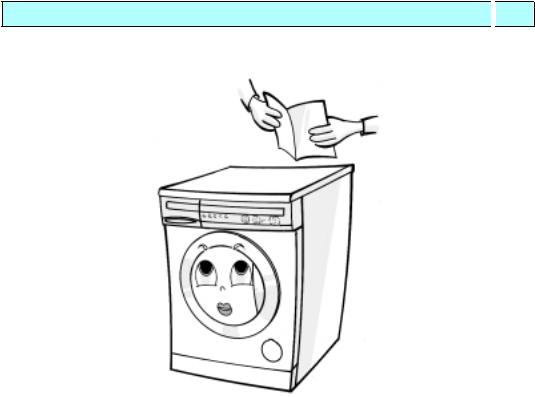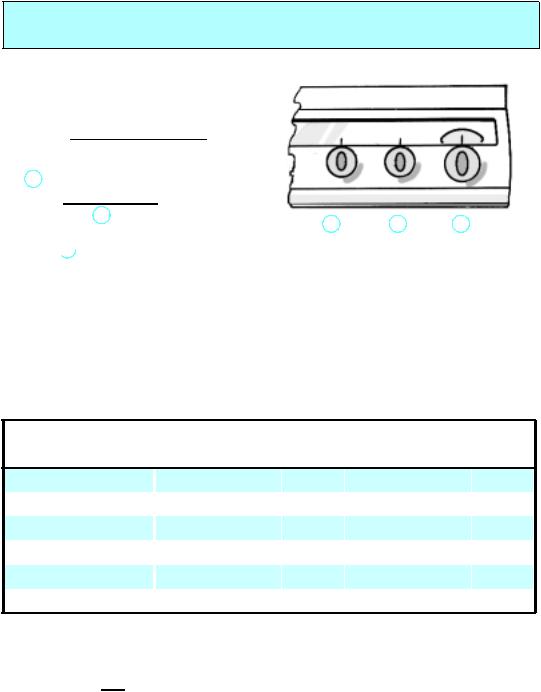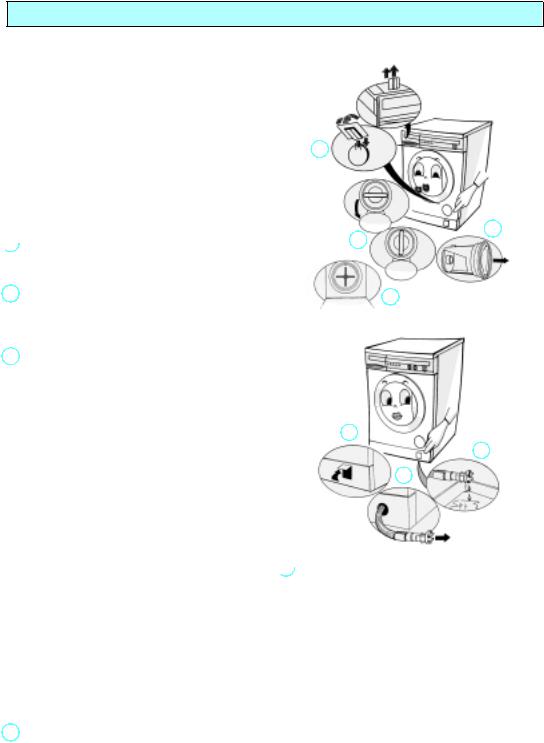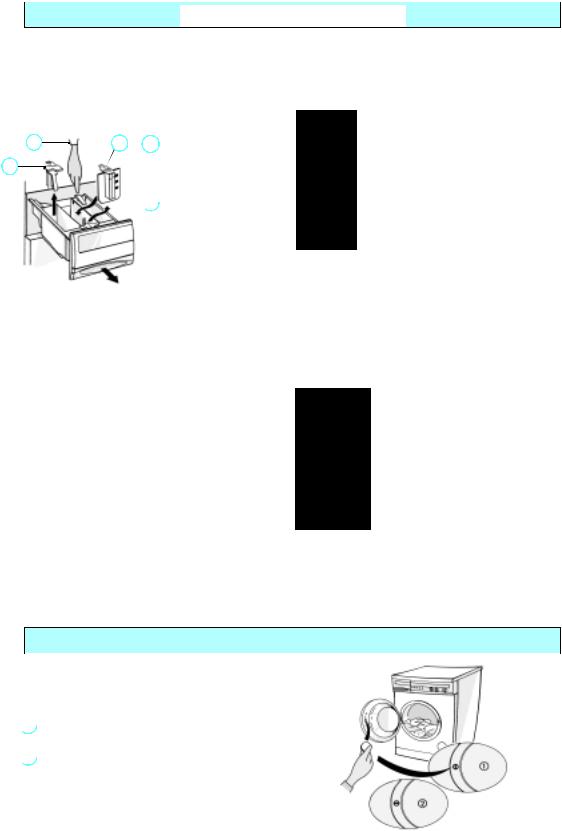Whirlpool AWM 283 User Manual [de]

QUICK REFERENCE GUIDE |
|
GB |
BEFORE USING THE APPLIANCE FOR THE FIRST TIME:
•IMPORTANT: MAKE SURE YOU HAVE READ THE “INSTALLATION INSTRUCTIONS”
•REMOVE THE TRANSIT BOLTS BEFORE USING THE MACHINE FOR THE FIRST TIME
•First wash cycle without laundry:
1.Open the tap(s).
2.Close the door.
3.Pour a little detergent (about 100 ml) into the detergent compartment  .
.
4.Select a short wash programme (see programme chart).
5.The ON light will light up to show that the appliance is operating.
6.Hold down the Start button for about one second.
This will remove any water remaining in the machine from the manufacturer's test run.
ROUTINE WASHES:
1.Open the tap(s).
2.Sort the laundry according to fabric type and colour and load the machine.
3.Close the door.
4.Add detergent and any additives required.
5.Select the programme, temperature, spin speed and special options.
6.Hold down the Start button for about one second.
IMPORTANT:
During the first 15 minutes of the Cotton and Synthetic programmes (without Prewash) you can open the door to add items to the wash.
This is not possible when the special option “Quick Wash” is selected.
21

GB |
|
|
CONTENTS |
|
APPLIANCE AND ACCESSORIES |
PAGE 23 |
|||
PROTECTING THE ENVIRONMENT |
PAGE 24 |
|||
SAFETY INSTRUCTIONS |
|
PAGE 24 |
||
MOVING AND TRANSPORTING THE APPLIANCE |
PAGE 24 |
|||
SORTING THE WASH |
|
PAGE 25 |
||
DETERGENT AND ADDITIVES |
PAGE 26 |
|||
DYEING AND BLEACHING |
|
PAGE 27 |
||
SELECTING THE PROGRAMME / PROGRAMME START PAGE 28 |
||||
SELECTING SPECIAL OPTIONS |
PAGE 29 |
|||
PROGRAMME SEQUENCE INDICATOR |
PAGE 30 |
|||
DOOR LOCK / PROGRAMME END |
PAGE 30 |
|||
PROGRAMME RESELECTION / |
PAGE 30 |
|||
INTERRUPTING THE PROGRAMME |
||||
REMOVING THE FILTER / |
|
PAGE 31 |
||
DRAINING RESIDUAL WATER |
||||
CARE AND MAINTENANCE |
PAGE 32 |
|||
CHILD SAFETY DEVICE |
|
PAGE 32 |
||
TROUBLE-SHOOTING GUIDE |
PAGE 33 |
|||
AFTER-SALES SERVICE |
|
PAGE 34 |
||
INSTALLATION INSTRUCTIONS |
PAGE 35 |
|||
22

APPLIANCE AND ACCESSORIES
1.Worktop
2.Control panel
3.Detergent drawer
4.After-Sales Service sticker (inside door)
5.Door
6.Door handle
-To open: press the button on the inside of the handle and pull
-To lock: press the door firmly (the lock will click into place)
7.Door lock child safety device (inside door)
8.Filter (behind hatch)
9.Residual water drain (depending on model).
23

PROTECTING THE ENVIRONMENT
•Packing
The packaging is marked with the recycling symbol  , signifying that it can be 100% recycled.
, signifying that it can be 100% recycled.
•Appliance
The appliance is made of recyclable materials. Dispose of the appliance in conformity with environmental regulations. Make it inoperable, pull out the plug and cut off the power cable so that the appliance cannot be connected to the mains.
•Eco-tips
-A full load (depending on the programme selected) gives the best energy and water consumption.
-Laundry which is lightly to moderately soiled does not require a prewash.
-Lightly soiled laundry should be washed at a low temperature or with a short programme.
-When washing small loads press the “Lightly Soiled / Half Load”  button (if present) and use less detergent.
button (if present) and use less detergent.
-If you wish to dry the laundry in a household dryer, use the highest spin speed (depending on the programme).
The dryer will then consume less energy.
-Do not exceed the recommended dosages on the detergent packet.
-Only use stain remover or bleach if absolutely necessary.
SAFETY INSTRUCTIONS
•The appliance must only be used in the household for the prescribed uses.
•All connections to the water and electrical mains must be made in accordance with the manufacturer's instructions and following local utility company safety regulations (see Installation Instructions).
•Before any cleaning and maintenance switch off the machine or disconnect it from the mains.
•Switch off the washing machine and turn off the tap(s) whenever the machine is not in use.
•Never use excessive force to open the door.
•Children must not be allowed to play with or inside the machine.
Do not rest any weight on the door.
•Packaging materials can be dangerous for children. Keep the packaging material (plastic bags, polystyrene, etc.) well out of their reach.
•The appliance conforms to European safety regulations, EC directive n. 93/68/EWG and EN 60555.
MOVING AND TRANSPORTING THE APPLIANCE
1.Pull out the mains plug.
2.Shut off the water tap(s).
3.Disconnect the inlet and drain hoses.
4.Drain residual water from the appliance and hoses (see “Removing The Filter / Draining Residual Water”).
5.Fit the transit bolts (see “Installation Instructions”).
24

SORTING THE WASH
1. Sort the load according to:
•Fabric type / care label symbol
Cotton, mixed fibres, synthetics, wool, silk, viscose.
•Colours
Separate coloured and white articles. Wash new coloured articles separately.
•Article size
Washing articles of different sizes together improves wash efficiency and distributes the load better in the drum.
•Fabric delicacy
Wash delicates separately.
Select the appropriate special programme for
machine-washable wool 
 , curtains or silk
, curtains or silk  and other delicate fabrics. Either remove curtain hooks or tie into a cloth bag. Only wash machine-washable fabrics. Wash small articles (e.g. nylon stockings, belts etc.) and articles with hooks (e.g. bras) in a cloth bag or pillow case with zip.
and other delicate fabrics. Either remove curtain hooks or tie into a cloth bag. Only wash machine-washable fabrics. Wash small articles (e.g. nylon stockings, belts etc.) and articles with hooks (e.g. bras) in a cloth bag or pillow case with zip.
2.Empty all pockets
Coins, safety pins etc. can damage the laundry, drum and tub.
3.Closures
Close zips and hooks and eyes. Loose belts or ribbons should be tied together.
WASHING AND CARING FOR SILK ARTICLES
Washing: To ensure correct care of silk articles
1.Check the care instructions on the label and make sure that the article is machinewashable (30°C).
2.Wash articles of the same colour preferably together.
Note: Check that new articles are colour fast and wash them separately the first time.
3.Use only special detergent for silk or wool.
4.This programme has no spin cycle.
5.If you select the “Rinse Hold” function, do not leave the wash in the rinse water for too long.
Drying and ironing
•Open the garment out on a towel and squeeze the water out without wringing.
•Never dry silk garments in the sun.
•Iron from the reverse side when the fabric is still slightly damp.
•To avoid water marks, don't spray on water and don't use a steam iron.
1
2
3
STAIN REMOVAL
•Blood, milk, egg, and other organic substances are generally removed by the enzyme phase of the programme.
•To remove red wine, coffee, tea, grass and fruit stains, etc. add a biological stain removing agent to the main wash in compartment  or a chlorine bleach in compartment
or a chlorine bleach in compartment  of the detergent drawer (if fitted).
of the detergent drawer (if fitted).
•Particularly stubborn stains can be treated with stain remover before the wash.
LOADING THE WASH
 Open the door.
Open the door.
Load the articles one at a time, loosely into the drum, without overfilling.
 Close the door.
Close the door.
LOAD CAPACITY
See the separate programme chart.
Note: Overloading the machine reduces the wash efficiency and encourages creasing.
25

DETERGENT AND ADDITIVES
CHOOSING THE RIGHT DETERGENT
The type of detergent depends on:
•the type of fabric (cottons, synthetics, delicates, wool, silk);
Note: Use only specific detergents for washing wool and silk articles;
•colour;
•wash temperature;
•degree and type of soiling.
Note:
•Whitish residues on dark fabrics are due to the insoluble water softeners in modern phosphate-free detergents. If this occurs, shake or brush out the fabric or use liquid detergents.
•Keep detergents and additives in a safe, dry place out of the reach of children.
•Use only detergent and fabric conditioner specifically produced for automatic domestic washing machines.
•When using water softeners, descaling agents and dyes, make sure that they are suitable for use in domestic washing machines.
•Do not use solvents in the machine (e.g. turpentine, benzine, etc.). Do not wash fabrics in the machine which have been treated with solvents or flammable liquids.
DETERGENT DOSAGES
Do not exceed manufacturers' recommended dosages as shown on the detergent package. The amounts depend on:
•degree and type of soiling;
•size of wash;
-full load: according to manufacturers' instructions;
-half load: 3/4 of the normal amount;
-minimum load (about 1 kg): 1/2 the amount used for full load;
•water hardness in your area (request information from the water company): soft water requires less detergent than hard water.
Note:
•Overdosing the detergent results in excessive foaming and reduces the wash efficiency. If the washing machine detects too much foam, it may prevent spinning.
•Using insufficient detergent results in grey laundry. The heating elements and drum also build up scale.
•If using chlorine bleach, follow the bleach instructions carefully. Overdosing the bleach can damage the wash.
WATER HARDNESS
WATER HARDNESS |
CHARACTERISTICS |
GERMAN |
FRENCH |
ENGLISH |
|
CATEGORY |
°DH |
°FH |
°EH |
||
|
|||||
1 |
soft |
0-7 |
0-12 |
0-9 |
|
2 |
medium |
7-14 |
12-25 |
9-17 |
|
3 |
hard |
14-21 |
25-37 |
17-26 |
|
4 |
very hard |
over 21 |
over 37 |
over 26 |
|
|
|
|
|
|
If the machine has a three chamber detergent drawer set the hardness pointer to the domestic water hardness level. Move the hardness pointer sideways to the desired position.
26

DETERGENT AND ADDITIVES
FILLING THE DETERGENT AND ADDITIVES
The drawer will have three or four chambers depending on the appliance model.
1.Pull out the detergent drawer.
2.Filling the detergent:
•Programmes with preand
main wash.
•Main wash programmes without
prewash.
When using liquid detergent, extract the coloured insert from the drawer and put it in the compartment  .
.
The insert has a scale to make dosing easier.
•Add fabric softeners and conditioners - no further than the “Max” mark (three chamber models) or the
“100 ml” mark (four chamber models).
•Fill chlorine bleach only to the “Max”
mark (if model is suited to its use).
• Stain remover.
•Water softener (water hardness class 4). 
•Starching.
Dissolve / dilute the starch, powder or liquid, in approximately 1 litre
of water in a container. Load the machine, close the door, select “Rinse and Spin” and start.
Once the machine has started filling, pour the dissolved starch into
detergent dispenser chamber  . Flush the chamber straight away by adding about half a liter of water.
. Flush the chamber straight away by adding about half a liter of water.
3. Slide the drawer in until it clicks shut.
Note:
•When using highly concentrated detergents, use the special detergent ball provided with the detergent and place it directly in the drum to avoid dispensing problems (for programmes without prewash only).
•For programmes with prewash: liquid detergents can be used for the prewash. For the main wash a powder detergent has to be used.
•Dose the correct amount of concentrated fabric softener and dilute with water up to the “Max” mark (three chamber models) or the “100 ml” mark (four chamber models) in the softener compartment.
Detergent drawer with 3 chambers
Detergent drawer with 4 chambers
DYEING AND BLEACHING
Dyeing: Commercially available products usually consist of a dye colour, fixing agent and salt. Pour the dye colour, fixing agent and salt directly into the empty drum, and only then load the laundry.
•Only use products designed for use in automatic washing machines.
•Follow the manufacturer's instructions.
•Plastic and rubber components of the machine can be stained by dyes or bleaches.
27

SELECTING THE PROGRAMME /
PROGRAMME START
SELECTING THE PROGRAMME
(See also the separate programme chart and consumption data)
1. |
Open the tap(s). |
|
|
|
2. |
Turn the programme selector knob to the |
|
|
|
|
desired programme. The Pilot lamp will light |
|
|
|
|
up to show that the machine is operating. |
|
|
|
|
. |
|
|
|
3. |
Set the temperature knob to the desired |
|
|
|
|
temperature |
. |
2 |
1 |
|
|
3 |
||
4.Turn the spin speed selector to the desired speed  .
.
Note:
1.When “No Spin”  is selected :
is selected :
•The “Wool” and “Delicates” programmes do not run any spin cycle.
•The “Cotton” and “Synthetic” programmes run a reduced speed spin cycle between rinses to ensure effective rinsing.
At the end of the programme a short spin is run.
2.Each programme has a predetermined automatic maximum spin speed as follows:
Programme |
|
MAX. SPIN SPEED in rpm (depending on model) |
|
|
|||||
|
1200 |
|
1000 |
|
900 |
|
800 |
|
600 |
|
1100 |
|
|
|
|||||
Cotton |
1200 |
1100 |
1000 |
|
900 |
|
800 |
|
600 |
Synthetic |
900* |
900* |
900* |
|
900 |
|
800 |
|
600 |
Delicates |
900* |
900* |
900* |
|
900 |
|
800 |
|
600 |
Wool |
900* |
900* |
900* |
|
900 |
|
800 |
|
600 |
Rinse + spin |
1200 |
1100 |
1000 |
|
900 |
|
800 |
|
600 |
Gentle spin |
900* |
900* |
900* |
|
900 |
|
800 |
|
600 |
|
|
|
|
|
|
|
|
|
|
* For improved garment care, the real spin speed is here reduced to 900 rpm.
5.Select special options as desired (see the next section).
6.Hold down the Start button for about 1 second.
28

SELECTING SPECIAL OPTIONS
(Depending on model, see also the separate programme chart).
Prewash button 
•Only select for washing heavily soiled laundry
(sand and grainy dirt).
•The prewash cycle adds 15 minutes to the programme time.
Rinse hold button 
•The laundry remains in the last rinse water without being spun, to avoid heavy creasing and prevent colours from dranging.
•Especially suitable for the “Synthetic” or “Delicate” programmes, if the laundry is not to be unloaded immediately after the end of the programme.
•Stopping Rinse Hold :
Press the Rinse Hold button again; the load will be spun automatically according to the selected programme.
Intensive Rinse button 
•Increases the rinsing time and water quantity, for an even more thorough rinse.
•The intensive rinse function is especially suitable for areas with particularly soft water, for baby clothes and to help people with allergies.
Quick Wash / Rapid button  /
/ 
•Select for quick, economical washes.
•Especially suitable for small, lightly soiled loads.
Lightly soiled (Half load) 
•Reduces water consumption, above all during the rinse.
•Especially suitable for lightly soiled or small loads (reduce the detergent quantity).
Energy save / Eco button 
•Increases the washing time and reduces the temperature. This reduces energy consumption by about 30% without compromising the excellent results of the wash.
29

PROGRAMME SEQUENCE INDICATOR
Indicates the programme selected and the current step in the sequence.
Green zone: Main wash. Black stripes: Rinse.
Solid black zone: Final spin.
“Stop”: Programme end.
DOOR LOCK / PROGRAMME END
DOOR LOCK
The door locks automatically after the programme start until the end of the programme. IMPORTANT: During the first 15 minutes of the Cotton and Synthetic programmes (without Prewash) you can open the door to add items to the wash. This is not possible when the special option “Quick Wash / Rapid” is selected.
If the programme selector is set to “0” or the electrical supply is interrupted, the door lock will open after approximately 2 minutes.
PROGRAMME END
1.The programme sequence indicator is at “Stop”. Only attempt to open the door after this.
2.Set the programme selector to “0”. The indicator light turns off.
3.Cancel the special options by pressing the appropriate buttons.
4.Open the door and unload the machine.
5.Turn off the tap(s).
Note: Do not fully close the door but leave it ajar to allow the drum to dry out.
PROGRAMME RESELECTION / INTERRUPTING THE PROGRAMME
PROGRAMME RESELECTION
a.CONTINUING WITH A NEW PROGRAMME OR TEMPERATURE SETTING
1.Select the new programme or temperature.
2.Hold down the Start button for about 1 second.
The new programme will continue fwith the same programme step at which the previous programme was interrupted.
b.CANCELLING THE CURRENT PROGRAMME AND RESTARTING WITH A DIFFERENT ONE
There's no need to add more detergent when you start the new programme, since almost no water is drained out when a programme is cancelled.
1.Hold down the Start button for about 5 seconds or until the programme control audibly restarts.
2.Wait until the programme sequence indicator reaches “Stop”.
3.Set the programme selector to “0”.
4.Set the programme selector to the new programme, selecting the new temperature and any special functions required.
5.Hold down the Start button for about 1 second.
TO INTERRUPT / PAUSE A PROGRAMME
To interrupt a programme that is already running and then restart it later:
1.Set the programme selector to “0”.
2.After the desired break, reselect the programme.
3.Hold down the Start button for about 1 second.
The programme will continue from where it was interrupted.
TO STOP A PROGRAMME BEFORE THE END / DRAINING
To stop the programme before it has finished and drain the water:
1.Set the programme selector to “B” (Gentle spin).
2.Set the Spin Speed selector to  (No spin).
(No spin).
3.Hold down the Start button for about 1 second.
The machine drains.
Only open the door when the programme sequence indicator has reached “Stop”.
30

REMOVING THE FILTER / DRAINING RESIDUAL WATER
WHEN TO REMOVE THE FILTER
•Check and clean the filter at least 2 or 3 times a year.
•When the appliance does not drain or spin properly.
•When the pump is blocked by an object (buttons, coins, safety pins).
IMPORTANT: Before draining, make sure that the water has cooled.
REMOVING THE FILTER
1.Switch off the appliance (set the programme selector to “0”).
 Open the filter cover using the coloured insert from the detergent drawer.
Open the filter cover using the coloured insert from the detergent drawer.
3. Place a tub or container beneath it.
Slowly turn the filter anticlockwise until its handle is vertical without unscrewing it completely.
5.Wait until all the water has drained.
Now unscrew the filter completely and remove it.
7. Remove any foreign material from the filter.  Check that the pump rotor moves freely.
Check that the pump rotor moves freely.
9.Insert the filter and screw it in clockwise until it locks (until the grip is horizontal).
10.Close the cover.
11.Pour 1/2 litre of water into the detergent drawer to reactivate the Eco system.
12.Select the desired programme and hold down the Start button for about 1 second.
WHEN TO DRAIN RESIDUAL WATER
•When transporting (moving) the machine.
•If there is danger of freezing in the installation room. In this case the machine should be drained after every wash.
DRAINING RESIDUAL WATER
The residual water drain hose (if provided) is located in the machine plinth. If the machine is not provided with a drain hose in the plinth, remove the filter to drain residual water (see “Removing The Filter”).
 Lift the cover upwards with light pressure.
Lift the cover upwards with light pressure.
Pull out the hose by about 15 cm. Pull off its endcap.
2.
6.
4.
8.
1.
3.
2.
 Let the water drain into a flat container until the flow stops.
Let the water drain into a flat container until the flow stops.
Close the drain hose and replace it.
4.On next use, pour about 1 litre of water into the detergent drawer to reactivate the Eco system.
31

CARE AND MAINTENANCE
APPLIANCE EXTERIOR AND CONTROL PANEL
•Clean using normal household detergent (do not use abrasive products).
•Dry with a soft cloth.
DETERGENT DRAWER
1 |
2 |
Disengage the |
2 |
|
drawer by pressing |
|
down the release |
lever and extract it.
 Remove the inserts (the siphon from the softener compartment, the siphon from the chlorine bleach compartment and the coloured insert for liquid detergent).
Remove the inserts (the siphon from the softener compartment, the siphon from the chlorine bleach compartment and the coloured insert for liquid detergent).
3.Wash all the parts under running water.
4.Reposition the inserts, make sure to push the siphons in until they lock and refit the drawer.
DOOR SEAL
•Clean with a damp cloth when necessary.
•Check the seal folds for foreign parts periodically.
WATER HOSE MESH FILTER
•Check and clean periodically.
For machines with a straight water supply hose (see figure):
Straight water supply hose
1.Turn off the tap(s).
2.Unscrew the hose(s) from the tap(s).
3.Remove the mesh filter and clean it.
4.Refit the filter and screw the hose connection to the tap.
5.Unscrew the hose(s) from the machine.
6.Remove the filter from the washing machine with pliers and clean it.
7.Replace the filter and screw the hose connection back on to the machine.
8.Turn on the tap(s) and ensure that the connections are completely water-tight.
For machines with Water Stop hose (see figure):
1. |
Turn off the tap. |
|
2. |
Unscrew the Water Stop |
|
3. |
hose from the tap. |
|
Remove only the loose filter |
||
4. |
and clean it. |
|
Refit the filter and screw the |
||
|
Water Stop hose to the tap. |
|
5. |
Turn on the tap and |
|
|
ensure that the |
|
Water Stop |
connection is completely |
|
water-tight. |
||
Hose |
FILTER
• Check and clean the filter at least 2 or 3 times a year (see “Removing The Filter”).
CHILD SAFETY DEVICE
To prevent improper use of the machine, turn the plastic screw on the inside of the appliance door with the thick, rounded edge of the coloured insert from the detergent drawer or using a coin.
 Vertical slot - safety position: door cannot lock into place.
Vertical slot - safety position: door cannot lock into place.
 Horizontal slot - normal position: door can be closed as before.
Horizontal slot - normal position: door can be closed as before.
32
